Report: Prevention of Childhood Obesity - International Relations
VerifiedAdded on 2022/08/13
|13
|2830
|21
Report
AI Summary
This report analyzes the issue of childhood obesity, focusing on prevention strategies within the context of international relations and healthcare. It examines government initiatives, such as the 'Sugar Tax,' designed to reduce sugar consumption and promote healthier eating habits. The report explores the impact of social media on children's eating behaviors, highlighting how advertisements for unhealthy foods and social media influencers contribute to obesity. It further discusses the lack of education about obesity and the importance of nutritional education programs in schools and families. The report also addresses community-focused projects that promote physical activity and healthy lifestyles. It references the Health and Social Care Committee and its inquiries into government progress on tackling childhood obesity, providing a comprehensive overview of the challenges and potential solutions in the fight against childhood obesity.
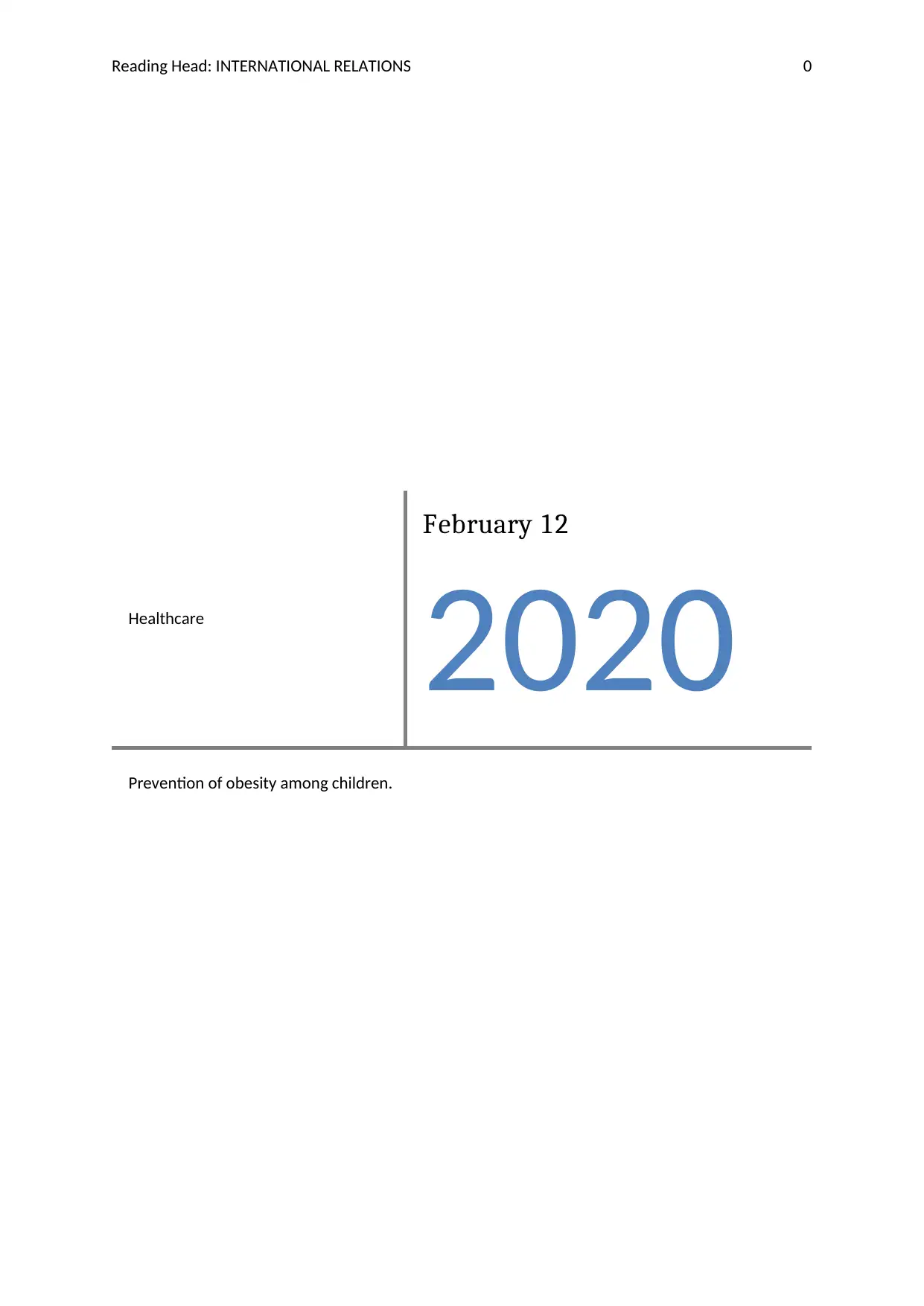
Reading Head: INTERNATIONAL RELATIONS 0
Healthcare
February 12
2020
Prevention of obesity among children.
Healthcare
February 12
2020
Prevention of obesity among children.
Paraphrase This Document
Need a fresh take? Get an instant paraphrase of this document with our AI Paraphraser
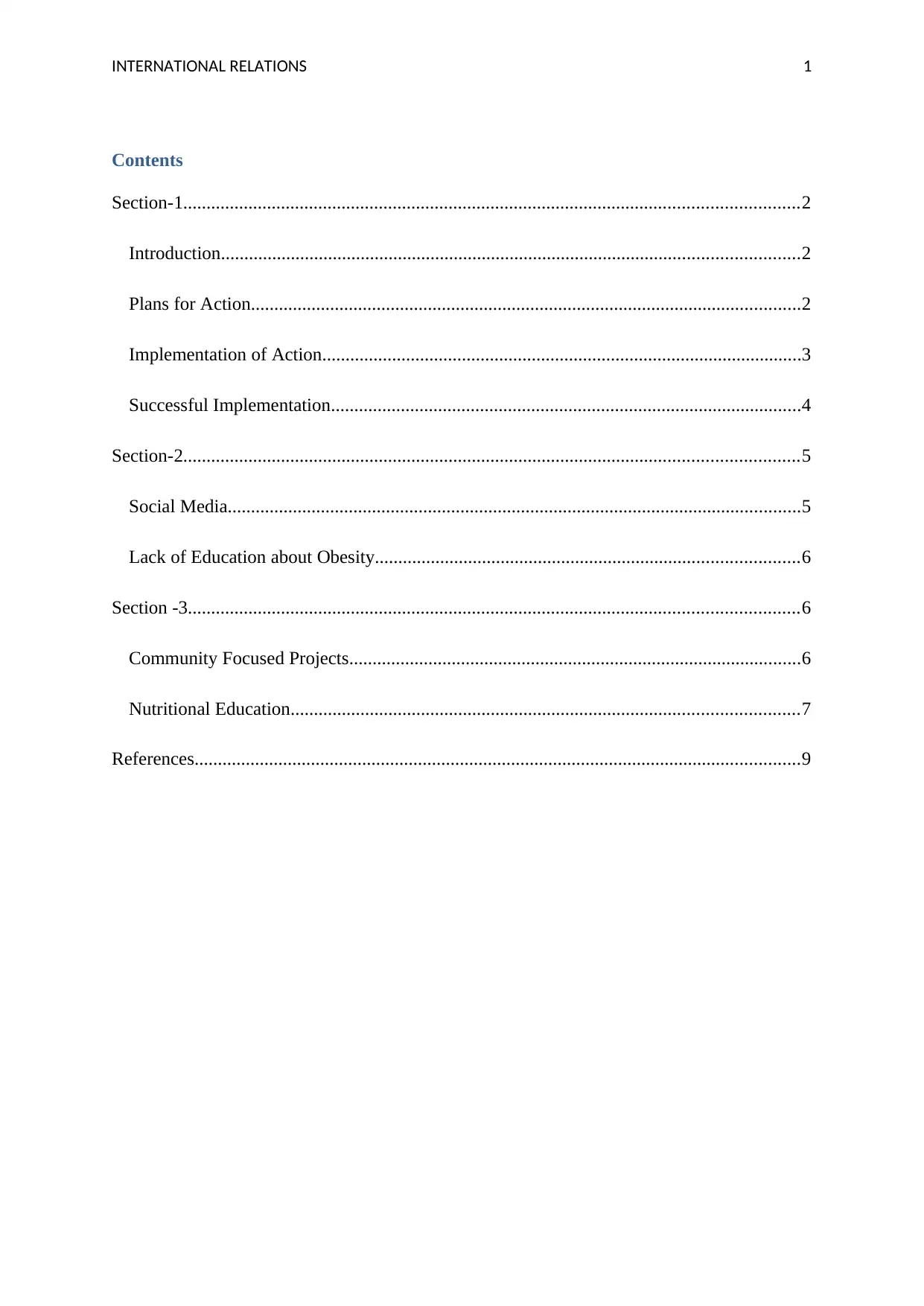
INTERNATIONAL RELATIONS 1
Contents
Section-1....................................................................................................................................2
Introduction............................................................................................................................2
Plans for Action......................................................................................................................2
Implementation of Action.......................................................................................................3
Successful Implementation.....................................................................................................4
Section-2....................................................................................................................................5
Social Media...........................................................................................................................5
Lack of Education about Obesity...........................................................................................6
Section -3...................................................................................................................................6
Community Focused Projects.................................................................................................6
Nutritional Education.............................................................................................................7
References..................................................................................................................................9
Contents
Section-1....................................................................................................................................2
Introduction............................................................................................................................2
Plans for Action......................................................................................................................2
Implementation of Action.......................................................................................................3
Successful Implementation.....................................................................................................4
Section-2....................................................................................................................................5
Social Media...........................................................................................................................5
Lack of Education about Obesity...........................................................................................6
Section -3...................................................................................................................................6
Community Focused Projects.................................................................................................6
Nutritional Education.............................................................................................................7
References..................................................................................................................................9
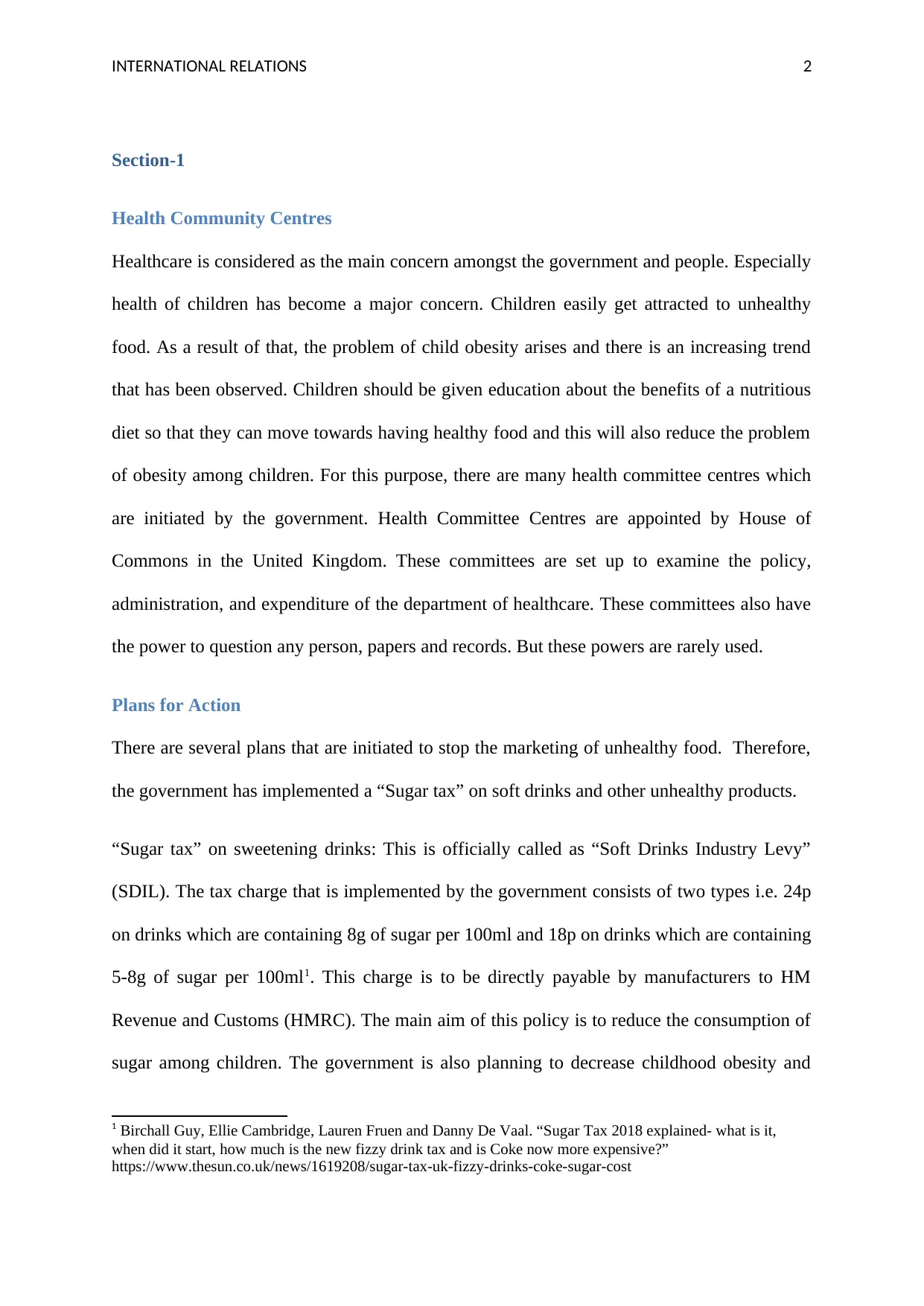
INTERNATIONAL RELATIONS 2
Section-1
Health Community Centres
Healthcare is considered as the main concern amongst the government and people. Especially
health of children has become a major concern. Children easily get attracted to unhealthy
food. As a result of that, the problem of child obesity arises and there is an increasing trend
that has been observed. Children should be given education about the benefits of a nutritious
diet so that they can move towards having healthy food and this will also reduce the problem
of obesity among children. For this purpose, there are many health committee centres which
are initiated by the government. Health Committee Centres are appointed by House of
Commons in the United Kingdom. These committees are set up to examine the policy,
administration, and expenditure of the department of healthcare. These committees also have
the power to question any person, papers and records. But these powers are rarely used.
Plans for Action
There are several plans that are initiated to stop the marketing of unhealthy food. Therefore,
the government has implemented a “Sugar tax” on soft drinks and other unhealthy products.
“Sugar tax” on sweetening drinks: This is officially called as “Soft Drinks Industry Levy”
(SDIL). The tax charge that is implemented by the government consists of two types i.e. 24p
on drinks which are containing 8g of sugar per 100ml and 18p on drinks which are containing
5-8g of sugar per 100ml1. This charge is to be directly payable by manufacturers to HM
Revenue and Customs (HMRC). The main aim of this policy is to reduce the consumption of
sugar among children. The government is also planning to decrease childhood obesity and
1 Birchall Guy, Ellie Cambridge, Lauren Fruen and Danny De Vaal. “Sugar Tax 2018 explained- what is it,
when did it start, how much is the new fizzy drink tax and is Coke now more expensive?”
https://www.thesun.co.uk/news/1619208/sugar-tax-uk-fizzy-drinks-coke-sugar-cost
Section-1
Health Community Centres
Healthcare is considered as the main concern amongst the government and people. Especially
health of children has become a major concern. Children easily get attracted to unhealthy
food. As a result of that, the problem of child obesity arises and there is an increasing trend
that has been observed. Children should be given education about the benefits of a nutritious
diet so that they can move towards having healthy food and this will also reduce the problem
of obesity among children. For this purpose, there are many health committee centres which
are initiated by the government. Health Committee Centres are appointed by House of
Commons in the United Kingdom. These committees are set up to examine the policy,
administration, and expenditure of the department of healthcare. These committees also have
the power to question any person, papers and records. But these powers are rarely used.
Plans for Action
There are several plans that are initiated to stop the marketing of unhealthy food. Therefore,
the government has implemented a “Sugar tax” on soft drinks and other unhealthy products.
“Sugar tax” on sweetening drinks: This is officially called as “Soft Drinks Industry Levy”
(SDIL). The tax charge that is implemented by the government consists of two types i.e. 24p
on drinks which are containing 8g of sugar per 100ml and 18p on drinks which are containing
5-8g of sugar per 100ml1. This charge is to be directly payable by manufacturers to HM
Revenue and Customs (HMRC). The main aim of this policy is to reduce the consumption of
sugar among children. The government is also planning to decrease childhood obesity and
1 Birchall Guy, Ellie Cambridge, Lauren Fruen and Danny De Vaal. “Sugar Tax 2018 explained- what is it,
when did it start, how much is the new fizzy drink tax and is Coke now more expensive?”
https://www.thesun.co.uk/news/1619208/sugar-tax-uk-fizzy-drinks-coke-sugar-cost
⊘ This is a preview!⊘
Do you want full access?
Subscribe today to unlock all pages.

Trusted by 1+ million students worldwide
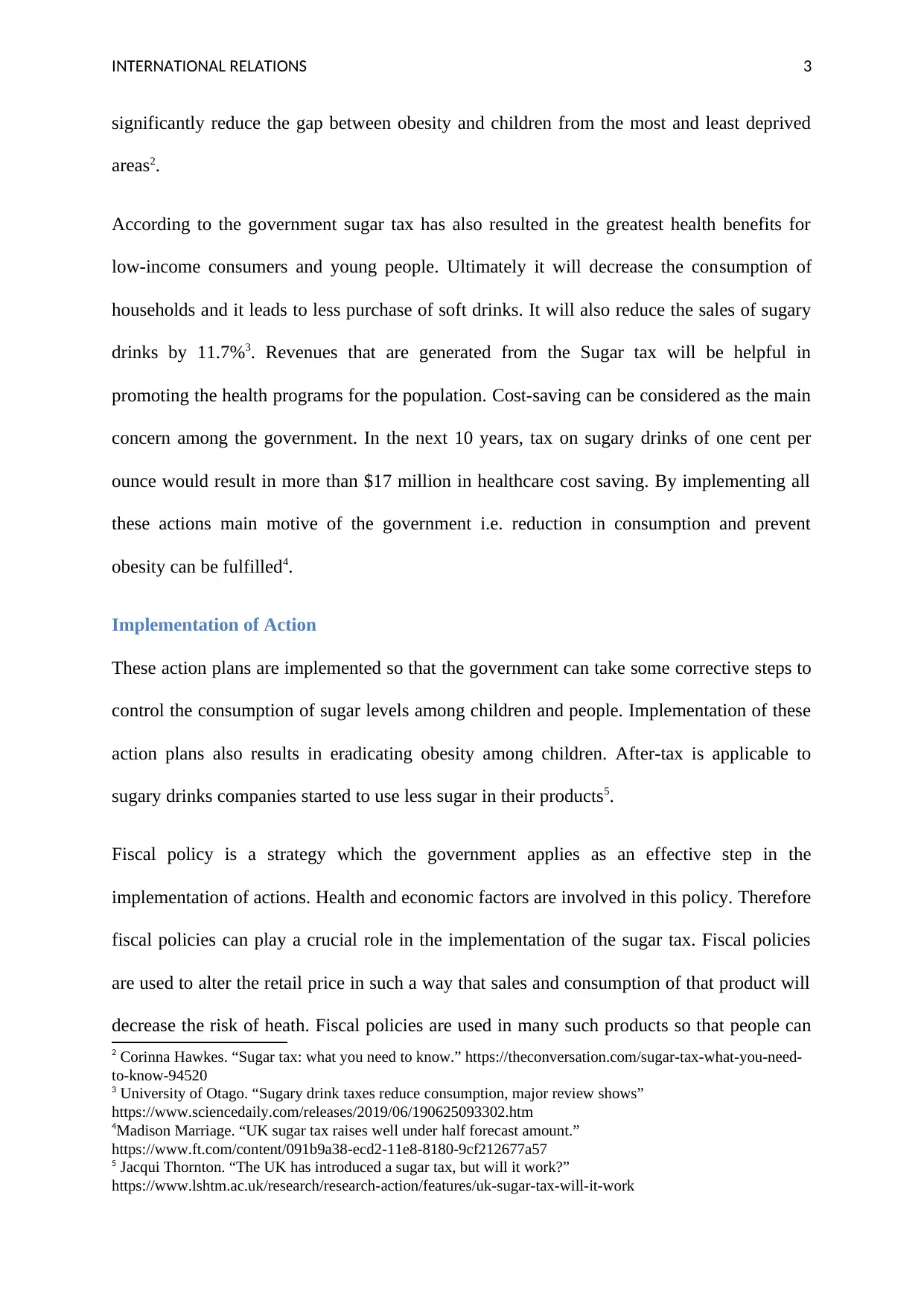
INTERNATIONAL RELATIONS 3
significantly reduce the gap between obesity and children from the most and least deprived
areas2.
According to the government sugar tax has also resulted in the greatest health benefits for
low-income consumers and young people. Ultimately it will decrease the consumption of
households and it leads to less purchase of soft drinks. It will also reduce the sales of sugary
drinks by 11.7%3. Revenues that are generated from the Sugar tax will be helpful in
promoting the health programs for the population. Cost-saving can be considered as the main
concern among the government. In the next 10 years, tax on sugary drinks of one cent per
ounce would result in more than $17 million in healthcare cost saving. By implementing all
these actions main motive of the government i.e. reduction in consumption and prevent
obesity can be fulfilled4.
Implementation of Action
These action plans are implemented so that the government can take some corrective steps to
control the consumption of sugar levels among children and people. Implementation of these
action plans also results in eradicating obesity among children. After-tax is applicable to
sugary drinks companies started to use less sugar in their products5.
Fiscal policy is a strategy which the government applies as an effective step in the
implementation of actions. Health and economic factors are involved in this policy. Therefore
fiscal policies can play a crucial role in the implementation of the sugar tax. Fiscal policies
are used to alter the retail price in such a way that sales and consumption of that product will
decrease the risk of heath. Fiscal policies are used in many such products so that people can
2 Corinna Hawkes. “Sugar tax: what you need to know.” https://theconversation.com/sugar-tax-what-you-need-
to-know-94520
3 University of Otago. “Sugary drink taxes reduce consumption, major review shows”
https://www.sciencedaily.com/releases/2019/06/190625093302.htm
4Madison Marriage. “UK sugar tax raises well under half forecast amount.”
https://www.ft.com/content/091b9a38-ecd2-11e8-8180-9cf212677a57
5 Jacqui Thornton. “The UK has introduced a sugar tax, but will it work?”
https://www.lshtm.ac.uk/research/research-action/features/uk-sugar-tax-will-it-work
significantly reduce the gap between obesity and children from the most and least deprived
areas2.
According to the government sugar tax has also resulted in the greatest health benefits for
low-income consumers and young people. Ultimately it will decrease the consumption of
households and it leads to less purchase of soft drinks. It will also reduce the sales of sugary
drinks by 11.7%3. Revenues that are generated from the Sugar tax will be helpful in
promoting the health programs for the population. Cost-saving can be considered as the main
concern among the government. In the next 10 years, tax on sugary drinks of one cent per
ounce would result in more than $17 million in healthcare cost saving. By implementing all
these actions main motive of the government i.e. reduction in consumption and prevent
obesity can be fulfilled4.
Implementation of Action
These action plans are implemented so that the government can take some corrective steps to
control the consumption of sugar levels among children and people. Implementation of these
action plans also results in eradicating obesity among children. After-tax is applicable to
sugary drinks companies started to use less sugar in their products5.
Fiscal policy is a strategy which the government applies as an effective step in the
implementation of actions. Health and economic factors are involved in this policy. Therefore
fiscal policies can play a crucial role in the implementation of the sugar tax. Fiscal policies
are used to alter the retail price in such a way that sales and consumption of that product will
decrease the risk of heath. Fiscal policies are used in many such products so that people can
2 Corinna Hawkes. “Sugar tax: what you need to know.” https://theconversation.com/sugar-tax-what-you-need-
to-know-94520
3 University of Otago. “Sugary drink taxes reduce consumption, major review shows”
https://www.sciencedaily.com/releases/2019/06/190625093302.htm
4Madison Marriage. “UK sugar tax raises well under half forecast amount.”
https://www.ft.com/content/091b9a38-ecd2-11e8-8180-9cf212677a57
5 Jacqui Thornton. “The UK has introduced a sugar tax, but will it work?”
https://www.lshtm.ac.uk/research/research-action/features/uk-sugar-tax-will-it-work
Paraphrase This Document
Need a fresh take? Get an instant paraphrase of this document with our AI Paraphraser
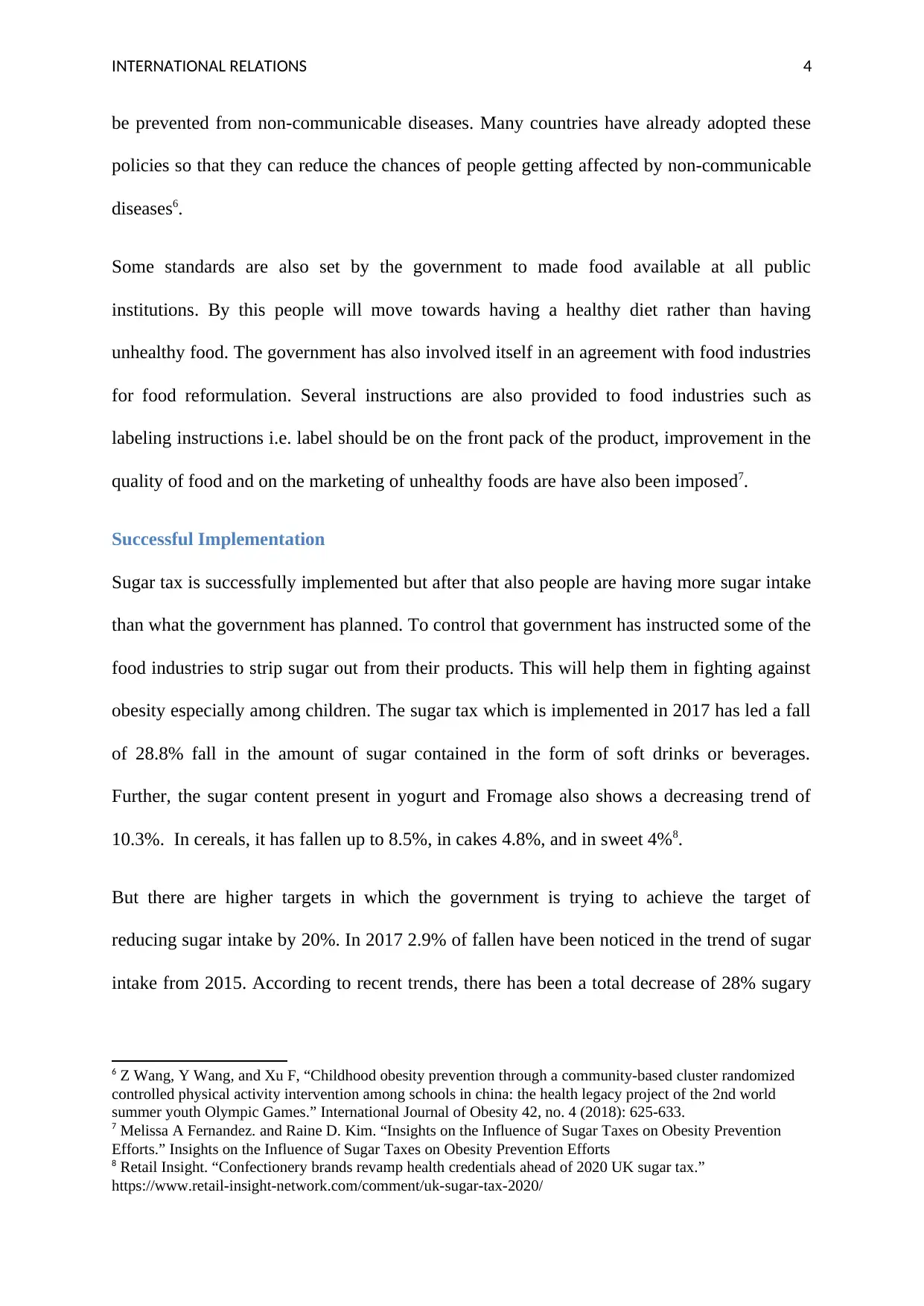
INTERNATIONAL RELATIONS 4
be prevented from non-communicable diseases. Many countries have already adopted these
policies so that they can reduce the chances of people getting affected by non-communicable
diseases6.
Some standards are also set by the government to made food available at all public
institutions. By this people will move towards having a healthy diet rather than having
unhealthy food. The government has also involved itself in an agreement with food industries
for food reformulation. Several instructions are also provided to food industries such as
labeling instructions i.e. label should be on the front pack of the product, improvement in the
quality of food and on the marketing of unhealthy foods are have also been imposed7.
Successful Implementation
Sugar tax is successfully implemented but after that also people are having more sugar intake
than what the government has planned. To control that government has instructed some of the
food industries to strip sugar out from their products. This will help them in fighting against
obesity especially among children. The sugar tax which is implemented in 2017 has led a fall
of 28.8% fall in the amount of sugar contained in the form of soft drinks or beverages.
Further, the sugar content present in yogurt and Fromage also shows a decreasing trend of
10.3%. In cereals, it has fallen up to 8.5%, in cakes 4.8%, and in sweet 4%8.
But there are higher targets in which the government is trying to achieve the target of
reducing sugar intake by 20%. In 2017 2.9% of fallen have been noticed in the trend of sugar
intake from 2015. According to recent trends, there has been a total decrease of 28% sugary
6 Z Wang, Y Wang, and Xu F, “Childhood obesity prevention through a community-based cluster randomized
controlled physical activity intervention among schools in china: the health legacy project of the 2nd world
summer youth Olympic Games.” International Journal of Obesity 42, no. 4 (2018): 625-633.
7 Melissa A Fernandez. and Raine D. Kim. “Insights on the Influence of Sugar Taxes on Obesity Prevention
Efforts.” Insights on the Influence of Sugar Taxes on Obesity Prevention Efforts
8 Retail Insight. “Confectionery brands revamp health credentials ahead of 2020 UK sugar tax.”
https://www.retail-insight-network.com/comment/uk-sugar-tax-2020/
be prevented from non-communicable diseases. Many countries have already adopted these
policies so that they can reduce the chances of people getting affected by non-communicable
diseases6.
Some standards are also set by the government to made food available at all public
institutions. By this people will move towards having a healthy diet rather than having
unhealthy food. The government has also involved itself in an agreement with food industries
for food reformulation. Several instructions are also provided to food industries such as
labeling instructions i.e. label should be on the front pack of the product, improvement in the
quality of food and on the marketing of unhealthy foods are have also been imposed7.
Successful Implementation
Sugar tax is successfully implemented but after that also people are having more sugar intake
than what the government has planned. To control that government has instructed some of the
food industries to strip sugar out from their products. This will help them in fighting against
obesity especially among children. The sugar tax which is implemented in 2017 has led a fall
of 28.8% fall in the amount of sugar contained in the form of soft drinks or beverages.
Further, the sugar content present in yogurt and Fromage also shows a decreasing trend of
10.3%. In cereals, it has fallen up to 8.5%, in cakes 4.8%, and in sweet 4%8.
But there are higher targets in which the government is trying to achieve the target of
reducing sugar intake by 20%. In 2017 2.9% of fallen have been noticed in the trend of sugar
intake from 2015. According to recent trends, there has been a total decrease of 28% sugary
6 Z Wang, Y Wang, and Xu F, “Childhood obesity prevention through a community-based cluster randomized
controlled physical activity intervention among schools in china: the health legacy project of the 2nd world
summer youth Olympic Games.” International Journal of Obesity 42, no. 4 (2018): 625-633.
7 Melissa A Fernandez. and Raine D. Kim. “Insights on the Influence of Sugar Taxes on Obesity Prevention
Efforts.” Insights on the Influence of Sugar Taxes on Obesity Prevention Efforts
8 Retail Insight. “Confectionery brands revamp health credentials ahead of 2020 UK sugar tax.”
https://www.retail-insight-network.com/comment/uk-sugar-tax-2020/
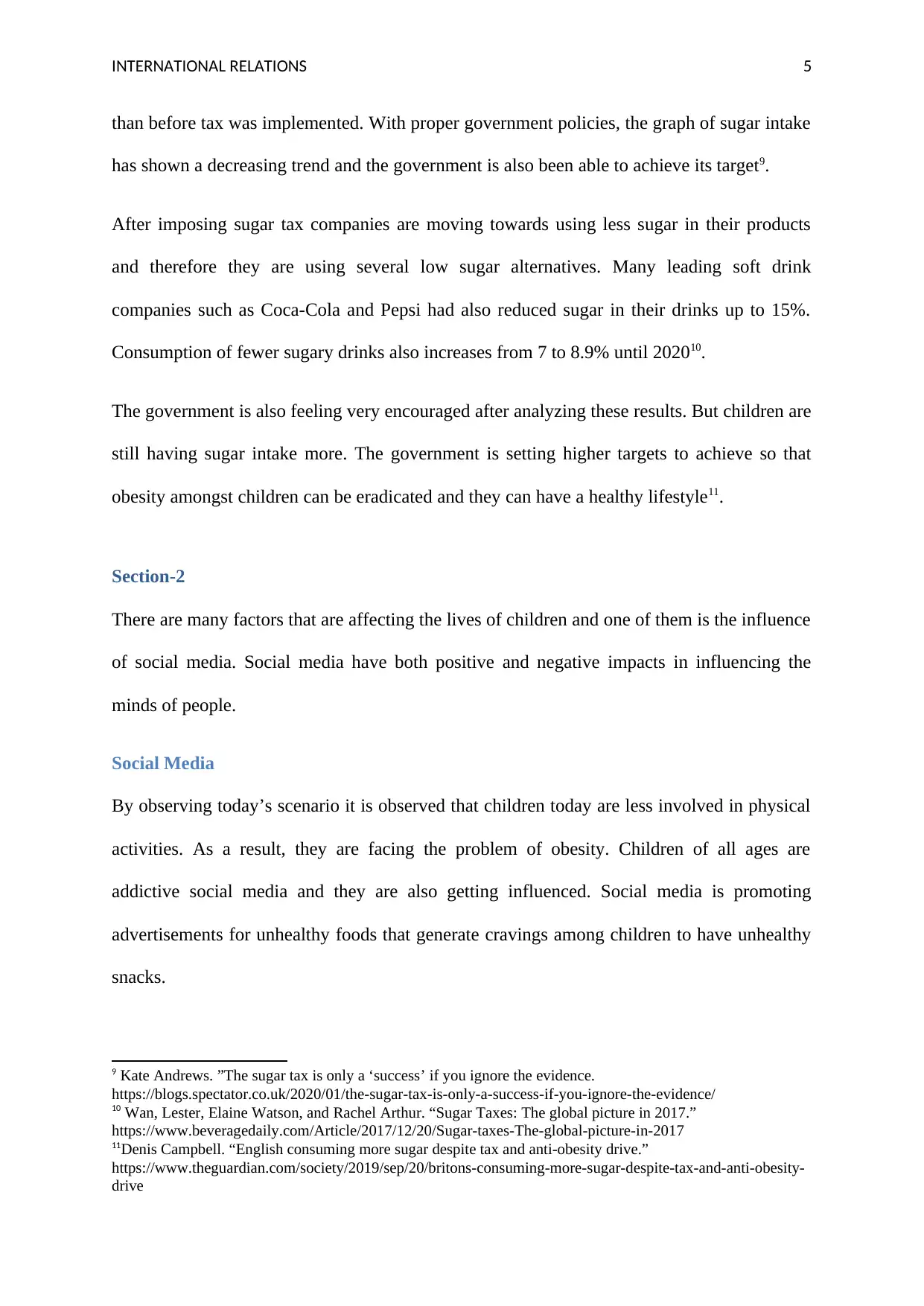
INTERNATIONAL RELATIONS 5
than before tax was implemented. With proper government policies, the graph of sugar intake
has shown a decreasing trend and the government is also been able to achieve its target9.
After imposing sugar tax companies are moving towards using less sugar in their products
and therefore they are using several low sugar alternatives. Many leading soft drink
companies such as Coca-Cola and Pepsi had also reduced sugar in their drinks up to 15%.
Consumption of fewer sugary drinks also increases from 7 to 8.9% until 202010.
The government is also feeling very encouraged after analyzing these results. But children are
still having sugar intake more. The government is setting higher targets to achieve so that
obesity amongst children can be eradicated and they can have a healthy lifestyle11.
Section-2
There are many factors that are affecting the lives of children and one of them is the influence
of social media. Social media have both positive and negative impacts in influencing the
minds of people.
Social Media
By observing today’s scenario it is observed that children today are less involved in physical
activities. As a result, they are facing the problem of obesity. Children of all ages are
addictive social media and they are also getting influenced. Social media is promoting
advertisements for unhealthy foods that generate cravings among children to have unhealthy
snacks.
9 Kate Andrews. ”The sugar tax is only a ‘success’ if you ignore the evidence.
https://blogs.spectator.co.uk/2020/01/the-sugar-tax-is-only-a-success-if-you-ignore-the-evidence/
10 Wan, Lester, Elaine Watson, and Rachel Arthur. “Sugar Taxes: The global picture in 2017.”
https://www.beveragedaily.com/Article/2017/12/20/Sugar-taxes-The-global-picture-in-2017
11Denis Campbell. “English consuming more sugar despite tax and anti-obesity drive.”
https://www.theguardian.com/society/2019/sep/20/britons-consuming-more-sugar-despite-tax-and-anti-obesity-
drive
than before tax was implemented. With proper government policies, the graph of sugar intake
has shown a decreasing trend and the government is also been able to achieve its target9.
After imposing sugar tax companies are moving towards using less sugar in their products
and therefore they are using several low sugar alternatives. Many leading soft drink
companies such as Coca-Cola and Pepsi had also reduced sugar in their drinks up to 15%.
Consumption of fewer sugary drinks also increases from 7 to 8.9% until 202010.
The government is also feeling very encouraged after analyzing these results. But children are
still having sugar intake more. The government is setting higher targets to achieve so that
obesity amongst children can be eradicated and they can have a healthy lifestyle11.
Section-2
There are many factors that are affecting the lives of children and one of them is the influence
of social media. Social media have both positive and negative impacts in influencing the
minds of people.
Social Media
By observing today’s scenario it is observed that children today are less involved in physical
activities. As a result, they are facing the problem of obesity. Children of all ages are
addictive social media and they are also getting influenced. Social media is promoting
advertisements for unhealthy foods that generate cravings among children to have unhealthy
snacks.
9 Kate Andrews. ”The sugar tax is only a ‘success’ if you ignore the evidence.
https://blogs.spectator.co.uk/2020/01/the-sugar-tax-is-only-a-success-if-you-ignore-the-evidence/
10 Wan, Lester, Elaine Watson, and Rachel Arthur. “Sugar Taxes: The global picture in 2017.”
https://www.beveragedaily.com/Article/2017/12/20/Sugar-taxes-The-global-picture-in-2017
11Denis Campbell. “English consuming more sugar despite tax and anti-obesity drive.”
https://www.theguardian.com/society/2019/sep/20/britons-consuming-more-sugar-despite-tax-and-anti-obesity-
drive
⊘ This is a preview!⊘
Do you want full access?
Subscribe today to unlock all pages.

Trusted by 1+ million students worldwide
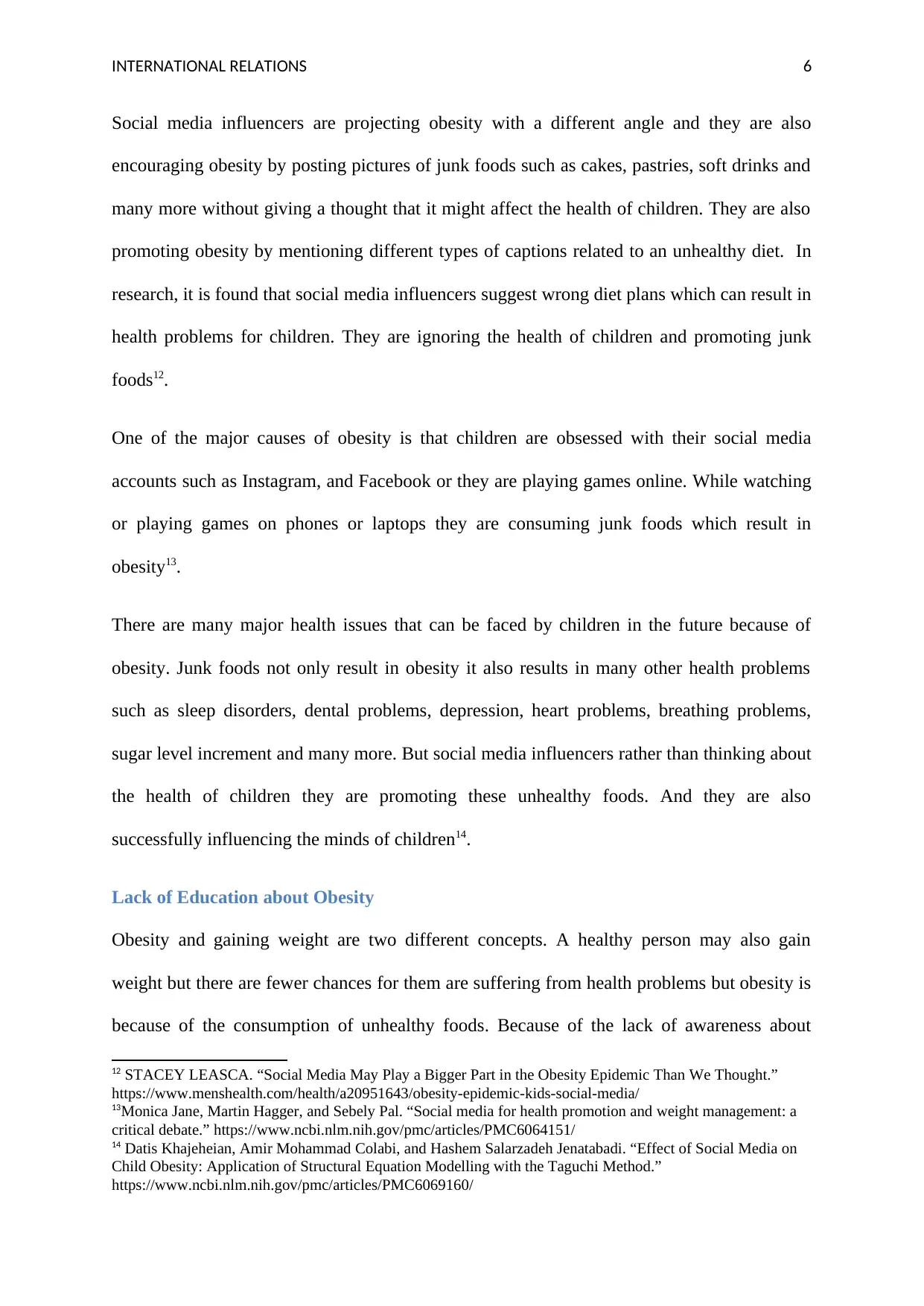
INTERNATIONAL RELATIONS 6
Social media influencers are projecting obesity with a different angle and they are also
encouraging obesity by posting pictures of junk foods such as cakes, pastries, soft drinks and
many more without giving a thought that it might affect the health of children. They are also
promoting obesity by mentioning different types of captions related to an unhealthy diet. In
research, it is found that social media influencers suggest wrong diet plans which can result in
health problems for children. They are ignoring the health of children and promoting junk
foods12.
One of the major causes of obesity is that children are obsessed with their social media
accounts such as Instagram, and Facebook or they are playing games online. While watching
or playing games on phones or laptops they are consuming junk foods which result in
obesity13.
There are many major health issues that can be faced by children in the future because of
obesity. Junk foods not only result in obesity it also results in many other health problems
such as sleep disorders, dental problems, depression, heart problems, breathing problems,
sugar level increment and many more. But social media influencers rather than thinking about
the health of children they are promoting these unhealthy foods. And they are also
successfully influencing the minds of children14.
Lack of Education about Obesity
Obesity and gaining weight are two different concepts. A healthy person may also gain
weight but there are fewer chances for them are suffering from health problems but obesity is
because of the consumption of unhealthy foods. Because of the lack of awareness about
12 STACEY LEASCA. “Social Media May Play a Bigger Part in the Obesity Epidemic Than We Thought.”
https://www.menshealth.com/health/a20951643/obesity-epidemic-kids-social-media/
13Monica Jane, Martin Hagger, and Sebely Pal. “Social media for health promotion and weight management: a
critical debate.” https://www.ncbi.nlm.nih.gov/pmc/articles/PMC6064151/
14 Datis Khajeheian, Amir Mohammad Colabi, and Hashem Salarzadeh Jenatabadi. “Effect of Social Media on
Child Obesity: Application of Structural Equation Modelling with the Taguchi Method.”
https://www.ncbi.nlm.nih.gov/pmc/articles/PMC6069160/
Social media influencers are projecting obesity with a different angle and they are also
encouraging obesity by posting pictures of junk foods such as cakes, pastries, soft drinks and
many more without giving a thought that it might affect the health of children. They are also
promoting obesity by mentioning different types of captions related to an unhealthy diet. In
research, it is found that social media influencers suggest wrong diet plans which can result in
health problems for children. They are ignoring the health of children and promoting junk
foods12.
One of the major causes of obesity is that children are obsessed with their social media
accounts such as Instagram, and Facebook or they are playing games online. While watching
or playing games on phones or laptops they are consuming junk foods which result in
obesity13.
There are many major health issues that can be faced by children in the future because of
obesity. Junk foods not only result in obesity it also results in many other health problems
such as sleep disorders, dental problems, depression, heart problems, breathing problems,
sugar level increment and many more. But social media influencers rather than thinking about
the health of children they are promoting these unhealthy foods. And they are also
successfully influencing the minds of children14.
Lack of Education about Obesity
Obesity and gaining weight are two different concepts. A healthy person may also gain
weight but there are fewer chances for them are suffering from health problems but obesity is
because of the consumption of unhealthy foods. Because of the lack of awareness about
12 STACEY LEASCA. “Social Media May Play a Bigger Part in the Obesity Epidemic Than We Thought.”
https://www.menshealth.com/health/a20951643/obesity-epidemic-kids-social-media/
13Monica Jane, Martin Hagger, and Sebely Pal. “Social media for health promotion and weight management: a
critical debate.” https://www.ncbi.nlm.nih.gov/pmc/articles/PMC6064151/
14 Datis Khajeheian, Amir Mohammad Colabi, and Hashem Salarzadeh Jenatabadi. “Effect of Social Media on
Child Obesity: Application of Structural Equation Modelling with the Taguchi Method.”
https://www.ncbi.nlm.nih.gov/pmc/articles/PMC6069160/
Paraphrase This Document
Need a fresh take? Get an instant paraphrase of this document with our AI Paraphraser
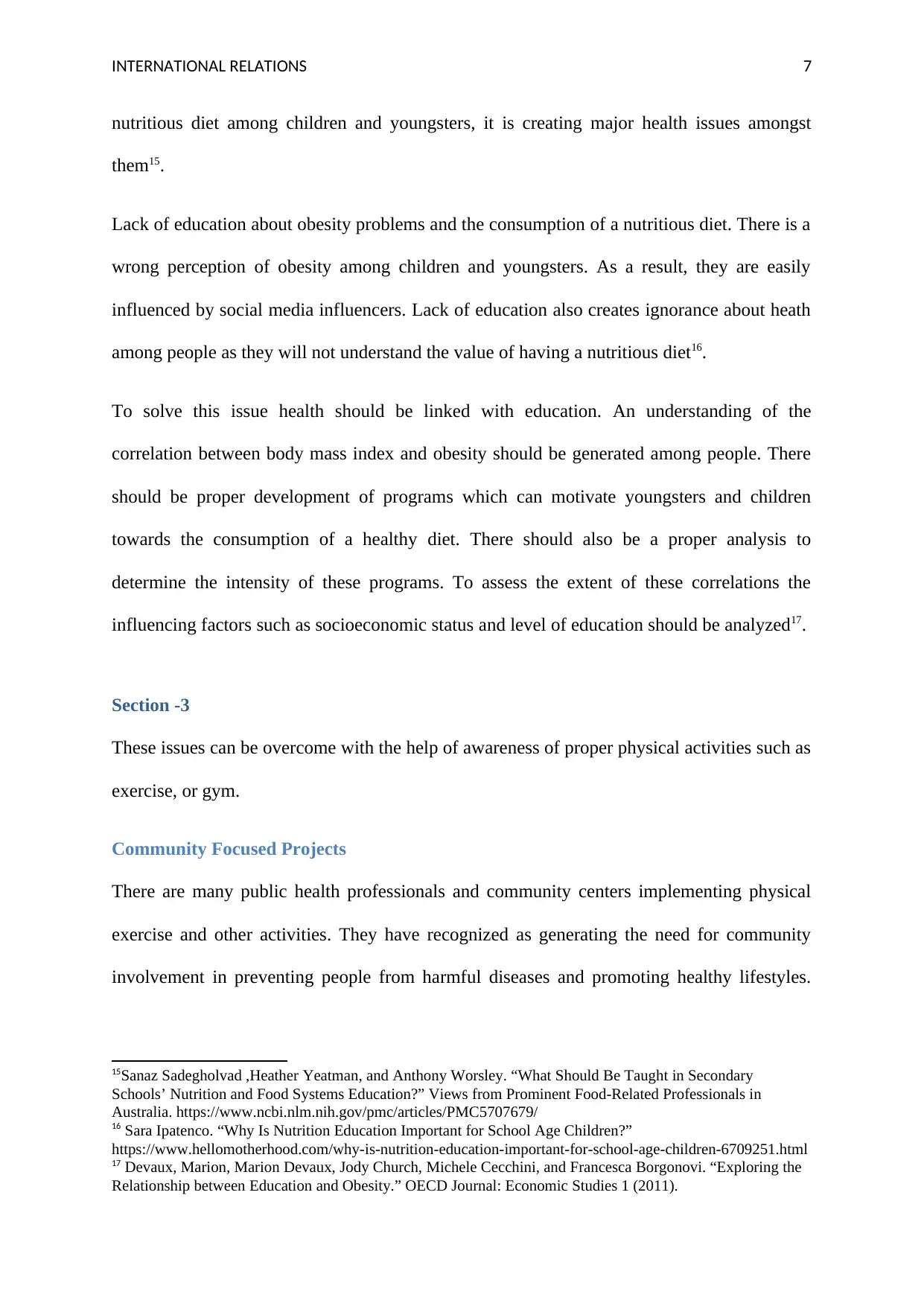
INTERNATIONAL RELATIONS 7
nutritious diet among children and youngsters, it is creating major health issues amongst
them15.
Lack of education about obesity problems and the consumption of a nutritious diet. There is a
wrong perception of obesity among children and youngsters. As a result, they are easily
influenced by social media influencers. Lack of education also creates ignorance about heath
among people as they will not understand the value of having a nutritious diet16.
To solve this issue health should be linked with education. An understanding of the
correlation between body mass index and obesity should be generated among people. There
should be proper development of programs which can motivate youngsters and children
towards the consumption of a healthy diet. There should also be a proper analysis to
determine the intensity of these programs. To assess the extent of these correlations the
influencing factors such as socioeconomic status and level of education should be analyzed17.
Section -3
These issues can be overcome with the help of awareness of proper physical activities such as
exercise, or gym.
Community Focused Projects
There are many public health professionals and community centers implementing physical
exercise and other activities. They have recognized as generating the need for community
involvement in preventing people from harmful diseases and promoting healthy lifestyles.
15Sanaz Sadegholvad ,Heather Yeatman, and Anthony Worsley. “What Should Be Taught in Secondary
Schools’ Nutrition and Food Systems Education?” Views from Prominent Food-Related Professionals in
Australia. https://www.ncbi.nlm.nih.gov/pmc/articles/PMC5707679/
16 Sara Ipatenco. “Why Is Nutrition Education Important for School Age Children?”
https://www.hellomotherhood.com/why-is-nutrition-education-important-for-school-age-children-6709251.html
17 Devaux, Marion, Marion Devaux, Jody Church, Michele Cecchini, and Francesca Borgonovi. “Exploring the
Relationship between Education and Obesity.” OECD Journal: Economic Studies 1 (2011).
nutritious diet among children and youngsters, it is creating major health issues amongst
them15.
Lack of education about obesity problems and the consumption of a nutritious diet. There is a
wrong perception of obesity among children and youngsters. As a result, they are easily
influenced by social media influencers. Lack of education also creates ignorance about heath
among people as they will not understand the value of having a nutritious diet16.
To solve this issue health should be linked with education. An understanding of the
correlation between body mass index and obesity should be generated among people. There
should be proper development of programs which can motivate youngsters and children
towards the consumption of a healthy diet. There should also be a proper analysis to
determine the intensity of these programs. To assess the extent of these correlations the
influencing factors such as socioeconomic status and level of education should be analyzed17.
Section -3
These issues can be overcome with the help of awareness of proper physical activities such as
exercise, or gym.
Community Focused Projects
There are many public health professionals and community centers implementing physical
exercise and other activities. They have recognized as generating the need for community
involvement in preventing people from harmful diseases and promoting healthy lifestyles.
15Sanaz Sadegholvad ,Heather Yeatman, and Anthony Worsley. “What Should Be Taught in Secondary
Schools’ Nutrition and Food Systems Education?” Views from Prominent Food-Related Professionals in
Australia. https://www.ncbi.nlm.nih.gov/pmc/articles/PMC5707679/
16 Sara Ipatenco. “Why Is Nutrition Education Important for School Age Children?”
https://www.hellomotherhood.com/why-is-nutrition-education-important-for-school-age-children-6709251.html
17 Devaux, Marion, Marion Devaux, Jody Church, Michele Cecchini, and Francesca Borgonovi. “Exploring the
Relationship between Education and Obesity.” OECD Journal: Economic Studies 1 (2011).
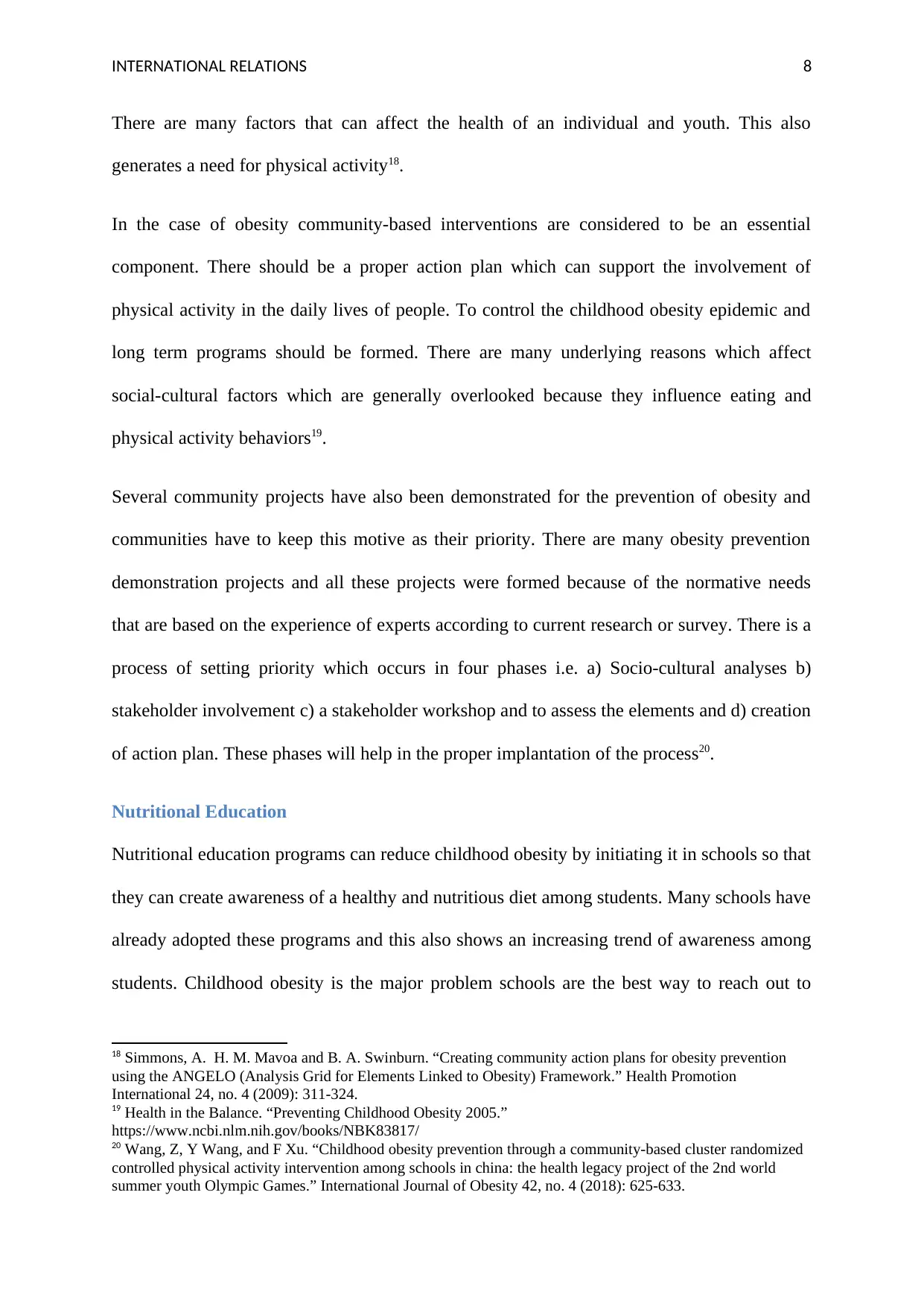
INTERNATIONAL RELATIONS 8
There are many factors that can affect the health of an individual and youth. This also
generates a need for physical activity18.
In the case of obesity community-based interventions are considered to be an essential
component. There should be a proper action plan which can support the involvement of
physical activity in the daily lives of people. To control the childhood obesity epidemic and
long term programs should be formed. There are many underlying reasons which affect
social-cultural factors which are generally overlooked because they influence eating and
physical activity behaviors19.
Several community projects have also been demonstrated for the prevention of obesity and
communities have to keep this motive as their priority. There are many obesity prevention
demonstration projects and all these projects were formed because of the normative needs
that are based on the experience of experts according to current research or survey. There is a
process of setting priority which occurs in four phases i.e. a) Socio-cultural analyses b)
stakeholder involvement c) a stakeholder workshop and to assess the elements and d) creation
of action plan. These phases will help in the proper implantation of the process20.
Nutritional Education
Nutritional education programs can reduce childhood obesity by initiating it in schools so that
they can create awareness of a healthy and nutritious diet among students. Many schools have
already adopted these programs and this also shows an increasing trend of awareness among
students. Childhood obesity is the major problem schools are the best way to reach out to
18 Simmons, A. H. M. Mavoa and B. A. Swinburn. “Creating community action plans for obesity prevention
using the ANGELO (Analysis Grid for Elements Linked to Obesity) Framework.” Health Promotion
International 24, no. 4 (2009): 311-324.
19 Health in the Balance. “Preventing Childhood Obesity 2005.”
https://www.ncbi.nlm.nih.gov/books/NBK83817/
20 Wang, Z, Y Wang, and F Xu. “Childhood obesity prevention through a community-based cluster randomized
controlled physical activity intervention among schools in china: the health legacy project of the 2nd world
summer youth Olympic Games.” International Journal of Obesity 42, no. 4 (2018): 625-633.
There are many factors that can affect the health of an individual and youth. This also
generates a need for physical activity18.
In the case of obesity community-based interventions are considered to be an essential
component. There should be a proper action plan which can support the involvement of
physical activity in the daily lives of people. To control the childhood obesity epidemic and
long term programs should be formed. There are many underlying reasons which affect
social-cultural factors which are generally overlooked because they influence eating and
physical activity behaviors19.
Several community projects have also been demonstrated for the prevention of obesity and
communities have to keep this motive as their priority. There are many obesity prevention
demonstration projects and all these projects were formed because of the normative needs
that are based on the experience of experts according to current research or survey. There is a
process of setting priority which occurs in four phases i.e. a) Socio-cultural analyses b)
stakeholder involvement c) a stakeholder workshop and to assess the elements and d) creation
of action plan. These phases will help in the proper implantation of the process20.
Nutritional Education
Nutritional education programs can reduce childhood obesity by initiating it in schools so that
they can create awareness of a healthy and nutritious diet among students. Many schools have
already adopted these programs and this also shows an increasing trend of awareness among
students. Childhood obesity is the major problem schools are the best way to reach out to
18 Simmons, A. H. M. Mavoa and B. A. Swinburn. “Creating community action plans for obesity prevention
using the ANGELO (Analysis Grid for Elements Linked to Obesity) Framework.” Health Promotion
International 24, no. 4 (2009): 311-324.
19 Health in the Balance. “Preventing Childhood Obesity 2005.”
https://www.ncbi.nlm.nih.gov/books/NBK83817/
20 Wang, Z, Y Wang, and F Xu. “Childhood obesity prevention through a community-based cluster randomized
controlled physical activity intervention among schools in china: the health legacy project of the 2nd world
summer youth Olympic Games.” International Journal of Obesity 42, no. 4 (2018): 625-633.
⊘ This is a preview!⊘
Do you want full access?
Subscribe today to unlock all pages.

Trusted by 1+ million students worldwide
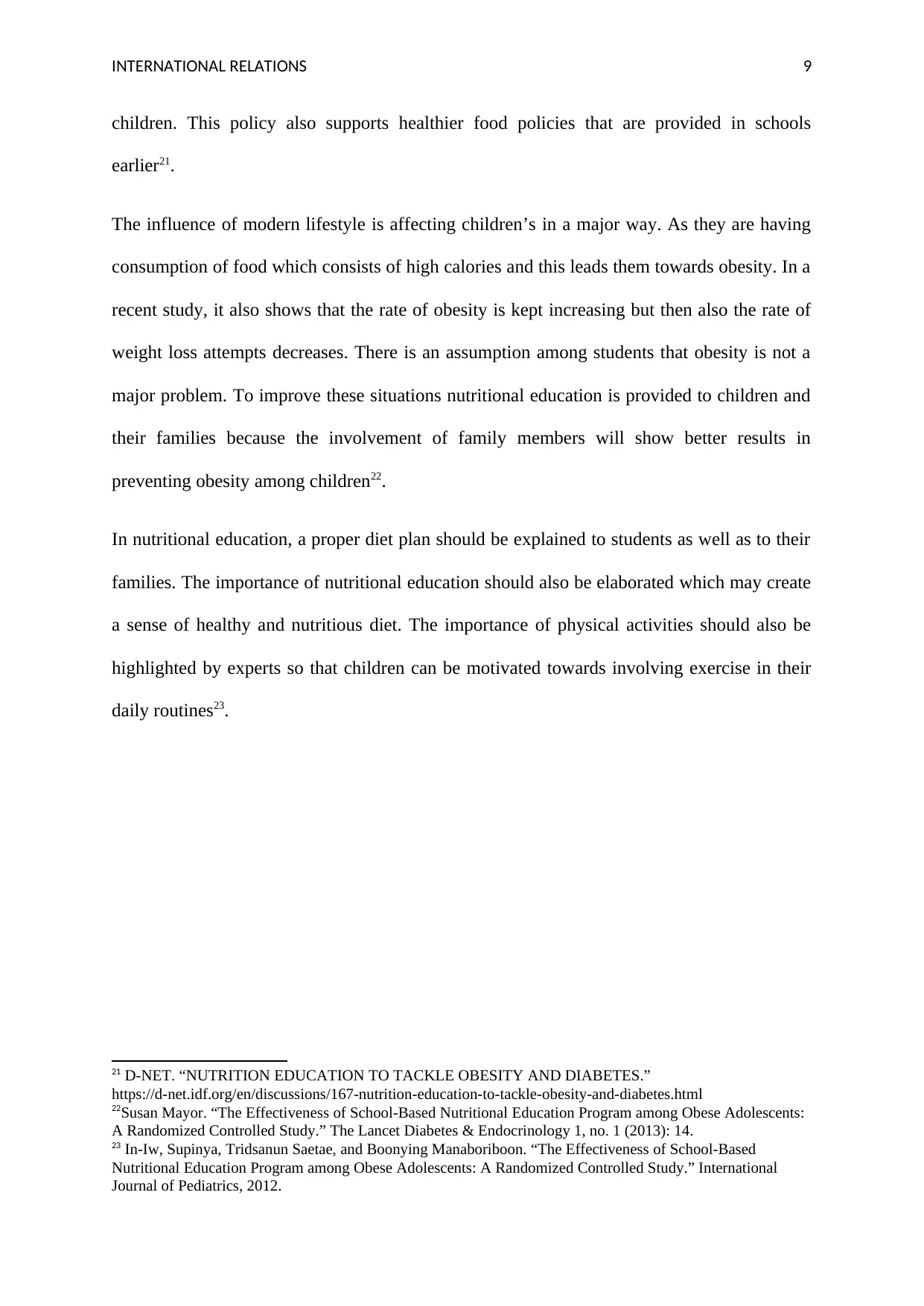
INTERNATIONAL RELATIONS 9
children. This policy also supports healthier food policies that are provided in schools
earlier21.
The influence of modern lifestyle is affecting children’s in a major way. As they are having
consumption of food which consists of high calories and this leads them towards obesity. In a
recent study, it also shows that the rate of obesity is kept increasing but then also the rate of
weight loss attempts decreases. There is an assumption among students that obesity is not a
major problem. To improve these situations nutritional education is provided to children and
their families because the involvement of family members will show better results in
preventing obesity among children22.
In nutritional education, a proper diet plan should be explained to students as well as to their
families. The importance of nutritional education should also be elaborated which may create
a sense of healthy and nutritious diet. The importance of physical activities should also be
highlighted by experts so that children can be motivated towards involving exercise in their
daily routines23.
21 D-NET. “NUTRITION EDUCATION TO TACKLE OBESITY AND DIABETES.”
https://d-net.idf.org/en/discussions/167-nutrition-education-to-tackle-obesity-and-diabetes.html
22Susan Mayor. “The Effectiveness of School-Based Nutritional Education Program among Obese Adolescents:
A Randomized Controlled Study.” The Lancet Diabetes & Endocrinology 1, no. 1 (2013): 14.
23 In-Iw, Supinya, Tridsanun Saetae, and Boonying Manaboriboon. “The Effectiveness of School-Based
Nutritional Education Program among Obese Adolescents: A Randomized Controlled Study.” International
Journal of Pediatrics, 2012.
children. This policy also supports healthier food policies that are provided in schools
earlier21.
The influence of modern lifestyle is affecting children’s in a major way. As they are having
consumption of food which consists of high calories and this leads them towards obesity. In a
recent study, it also shows that the rate of obesity is kept increasing but then also the rate of
weight loss attempts decreases. There is an assumption among students that obesity is not a
major problem. To improve these situations nutritional education is provided to children and
their families because the involvement of family members will show better results in
preventing obesity among children22.
In nutritional education, a proper diet plan should be explained to students as well as to their
families. The importance of nutritional education should also be elaborated which may create
a sense of healthy and nutritious diet. The importance of physical activities should also be
highlighted by experts so that children can be motivated towards involving exercise in their
daily routines23.
21 D-NET. “NUTRITION EDUCATION TO TACKLE OBESITY AND DIABETES.”
https://d-net.idf.org/en/discussions/167-nutrition-education-to-tackle-obesity-and-diabetes.html
22Susan Mayor. “The Effectiveness of School-Based Nutritional Education Program among Obese Adolescents:
A Randomized Controlled Study.” The Lancet Diabetes & Endocrinology 1, no. 1 (2013): 14.
23 In-Iw, Supinya, Tridsanun Saetae, and Boonying Manaboriboon. “The Effectiveness of School-Based
Nutritional Education Program among Obese Adolescents: A Randomized Controlled Study.” International
Journal of Pediatrics, 2012.
Paraphrase This Document
Need a fresh take? Get an instant paraphrase of this document with our AI Paraphraser
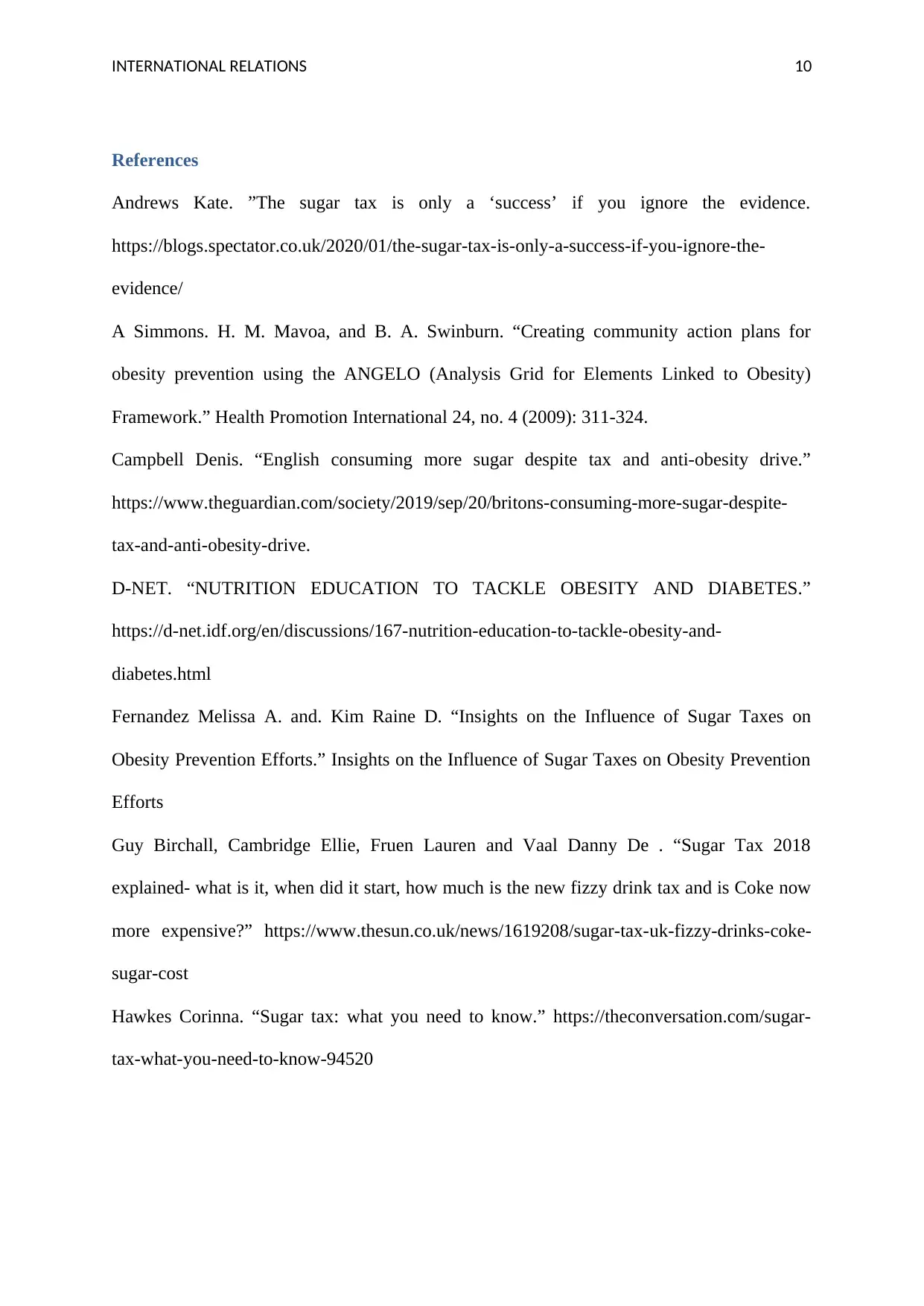
INTERNATIONAL RELATIONS 10
References
Andrews Kate. ”The sugar tax is only a ‘success’ if you ignore the evidence.
https://blogs.spectator.co.uk/2020/01/the-sugar-tax-is-only-a-success-if-you-ignore-the-
evidence/
A Simmons. H. M. Mavoa, and B. A. Swinburn. “Creating community action plans for
obesity prevention using the ANGELO (Analysis Grid for Elements Linked to Obesity)
Framework.” Health Promotion International 24, no. 4 (2009): 311-324.
Campbell Denis. “English consuming more sugar despite tax and anti-obesity drive.”
https://www.theguardian.com/society/2019/sep/20/britons-consuming-more-sugar-despite-
tax-and-anti-obesity-drive.
D-NET. “NUTRITION EDUCATION TO TACKLE OBESITY AND DIABETES.”
https://d-net.idf.org/en/discussions/167-nutrition-education-to-tackle-obesity-and-
diabetes.html
Fernandez Melissa A. and. Kim Raine D. “Insights on the Influence of Sugar Taxes on
Obesity Prevention Efforts.” Insights on the Influence of Sugar Taxes on Obesity Prevention
Efforts
Guy Birchall, Cambridge Ellie, Fruen Lauren and Vaal Danny De . “Sugar Tax 2018
explained- what is it, when did it start, how much is the new fizzy drink tax and is Coke now
more expensive?” https://www.thesun.co.uk/news/1619208/sugar-tax-uk-fizzy-drinks-coke-
sugar-cost
Hawkes Corinna. “Sugar tax: what you need to know.” https://theconversation.com/sugar-
tax-what-you-need-to-know-94520
References
Andrews Kate. ”The sugar tax is only a ‘success’ if you ignore the evidence.
https://blogs.spectator.co.uk/2020/01/the-sugar-tax-is-only-a-success-if-you-ignore-the-
evidence/
A Simmons. H. M. Mavoa, and B. A. Swinburn. “Creating community action plans for
obesity prevention using the ANGELO (Analysis Grid for Elements Linked to Obesity)
Framework.” Health Promotion International 24, no. 4 (2009): 311-324.
Campbell Denis. “English consuming more sugar despite tax and anti-obesity drive.”
https://www.theguardian.com/society/2019/sep/20/britons-consuming-more-sugar-despite-
tax-and-anti-obesity-drive.
D-NET. “NUTRITION EDUCATION TO TACKLE OBESITY AND DIABETES.”
https://d-net.idf.org/en/discussions/167-nutrition-education-to-tackle-obesity-and-
diabetes.html
Fernandez Melissa A. and. Kim Raine D. “Insights on the Influence of Sugar Taxes on
Obesity Prevention Efforts.” Insights on the Influence of Sugar Taxes on Obesity Prevention
Efforts
Guy Birchall, Cambridge Ellie, Fruen Lauren and Vaal Danny De . “Sugar Tax 2018
explained- what is it, when did it start, how much is the new fizzy drink tax and is Coke now
more expensive?” https://www.thesun.co.uk/news/1619208/sugar-tax-uk-fizzy-drinks-coke-
sugar-cost
Hawkes Corinna. “Sugar tax: what you need to know.” https://theconversation.com/sugar-
tax-what-you-need-to-know-94520
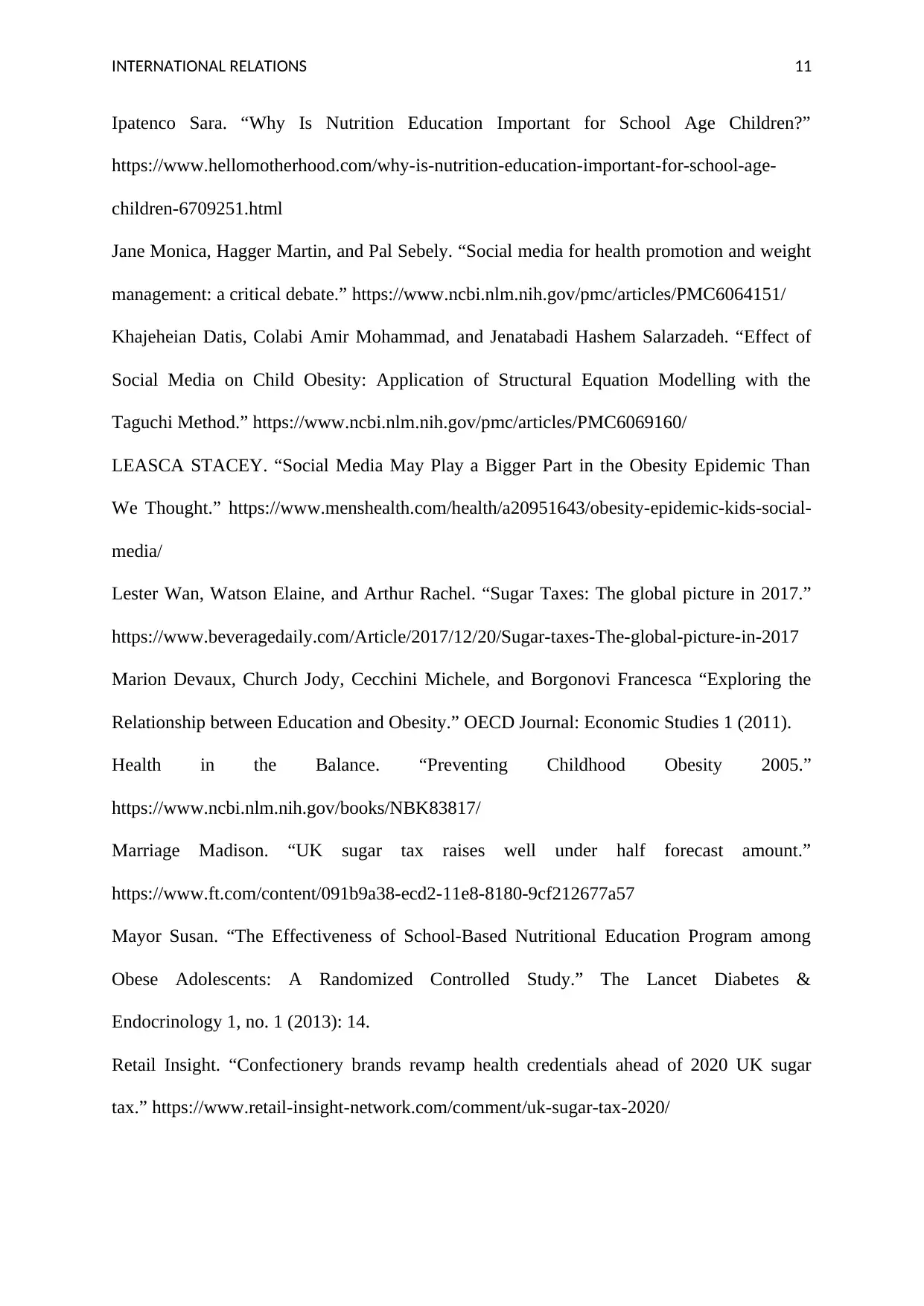
INTERNATIONAL RELATIONS 11
Ipatenco Sara. “Why Is Nutrition Education Important for School Age Children?”
https://www.hellomotherhood.com/why-is-nutrition-education-important-for-school-age-
children-6709251.html
Jane Monica, Hagger Martin, and Pal Sebely. “Social media for health promotion and weight
management: a critical debate.” https://www.ncbi.nlm.nih.gov/pmc/articles/PMC6064151/
Khajeheian Datis, Colabi Amir Mohammad, and Jenatabadi Hashem Salarzadeh. “Effect of
Social Media on Child Obesity: Application of Structural Equation Modelling with the
Taguchi Method.” https://www.ncbi.nlm.nih.gov/pmc/articles/PMC6069160/
LEASCA STACEY. “Social Media May Play a Bigger Part in the Obesity Epidemic Than
We Thought.” https://www.menshealth.com/health/a20951643/obesity-epidemic-kids-social-
media/
Lester Wan, Watson Elaine, and Arthur Rachel. “Sugar Taxes: The global picture in 2017.”
https://www.beveragedaily.com/Article/2017/12/20/Sugar-taxes-The-global-picture-in-2017
Marion Devaux, Church Jody, Cecchini Michele, and Borgonovi Francesca “Exploring the
Relationship between Education and Obesity.” OECD Journal: Economic Studies 1 (2011).
Health in the Balance. “Preventing Childhood Obesity 2005.”
https://www.ncbi.nlm.nih.gov/books/NBK83817/
Marriage Madison. “UK sugar tax raises well under half forecast amount.”
https://www.ft.com/content/091b9a38-ecd2-11e8-8180-9cf212677a57
Mayor Susan. “The Effectiveness of School-Based Nutritional Education Program among
Obese Adolescents: A Randomized Controlled Study.” The Lancet Diabetes &
Endocrinology 1, no. 1 (2013): 14.
Retail Insight. “Confectionery brands revamp health credentials ahead of 2020 UK sugar
tax.” https://www.retail-insight-network.com/comment/uk-sugar-tax-2020/
Ipatenco Sara. “Why Is Nutrition Education Important for School Age Children?”
https://www.hellomotherhood.com/why-is-nutrition-education-important-for-school-age-
children-6709251.html
Jane Monica, Hagger Martin, and Pal Sebely. “Social media for health promotion and weight
management: a critical debate.” https://www.ncbi.nlm.nih.gov/pmc/articles/PMC6064151/
Khajeheian Datis, Colabi Amir Mohammad, and Jenatabadi Hashem Salarzadeh. “Effect of
Social Media on Child Obesity: Application of Structural Equation Modelling with the
Taguchi Method.” https://www.ncbi.nlm.nih.gov/pmc/articles/PMC6069160/
LEASCA STACEY. “Social Media May Play a Bigger Part in the Obesity Epidemic Than
We Thought.” https://www.menshealth.com/health/a20951643/obesity-epidemic-kids-social-
media/
Lester Wan, Watson Elaine, and Arthur Rachel. “Sugar Taxes: The global picture in 2017.”
https://www.beveragedaily.com/Article/2017/12/20/Sugar-taxes-The-global-picture-in-2017
Marion Devaux, Church Jody, Cecchini Michele, and Borgonovi Francesca “Exploring the
Relationship between Education and Obesity.” OECD Journal: Economic Studies 1 (2011).
Health in the Balance. “Preventing Childhood Obesity 2005.”
https://www.ncbi.nlm.nih.gov/books/NBK83817/
Marriage Madison. “UK sugar tax raises well under half forecast amount.”
https://www.ft.com/content/091b9a38-ecd2-11e8-8180-9cf212677a57
Mayor Susan. “The Effectiveness of School-Based Nutritional Education Program among
Obese Adolescents: A Randomized Controlled Study.” The Lancet Diabetes &
Endocrinology 1, no. 1 (2013): 14.
Retail Insight. “Confectionery brands revamp health credentials ahead of 2020 UK sugar
tax.” https://www.retail-insight-network.com/comment/uk-sugar-tax-2020/
⊘ This is a preview!⊘
Do you want full access?
Subscribe today to unlock all pages.

Trusted by 1+ million students worldwide
1 out of 13
Related Documents
Your All-in-One AI-Powered Toolkit for Academic Success.
+13062052269
info@desklib.com
Available 24*7 on WhatsApp / Email
![[object Object]](/_next/static/media/star-bottom.7253800d.svg)
Unlock your academic potential
Copyright © 2020–2025 A2Z Services. All Rights Reserved. Developed and managed by ZUCOL.




